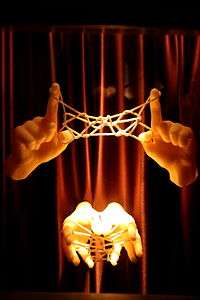Caroline Furness Jayne
Caroline Furness Jayne (1873–1909) was an American ethnologist. She wrote the best-known book on string figures, String Figures and How to Make Them: a study of cat's cradle in many lands, 1906.
The daughter of the Shakespearean scholar Horace Howard Furness, and a graduate of Philadelphia's Agnes Irwin School, she became the wife of Horace Jayne, a biology professor at the University of Pennsylvania. Her brother, William Henry Furness III, received his M.D. from the same university and was an "extensive traveler" and a fellow of the Anthropological Institute of Great Britain.
Her string figure mentor was Alfred Haddon, a Cambridge ethnologist who began the introduction to her book by noting that "in ethnology ... nothing is too insignificant to receive attention". He then goes on to defend the research invested in the unpromising amusement of string figures.[1] Jayne, an extensive traveler herself, was the first to create a popular study of string figures building on dry academic papers which had appeared in journals like The Annual Report of the Bureau of Ethnology and the Proceedings of the Royal Geographical Society as well as in a variety of foreign language anthropological journals. (These are listed in her Bibliography (pp. 396-98) and include papers by Dr Haddon (six) and 42 other researchers.)
String Figures and How to Make Them was first published in 1906 by Charles Scribner's Sons, New York (ISBN 0-8446-2318-0), and was reprinted by Dover Publications, New York in 1962 (LCCN: 62-51880); later reissues have ISBNs 0-613-81171-2 and 0-486-20152-X. It included figures illustrating every game and 16 portraits of players.
The Jaynes lived in Philadelphia in a city house at 19th & Delancey Sts., designed by her uncle, the architect Frank Furness. Their son, Horace H. F. Jayne, became the first curator of Chinese art at the Philadelphia Museum of Art, and later was director of the University of Pennsylvania Museum of Archaeology and Anthropology and a curator at the Metropolitan Museum of Art.
See also
References
- ↑ Haddon "Introduction" in Jayne, C. F. (1906); pp. xi-xxiii
External links
| Wikimedia Commons has media related to String Figures and How to Make Them. |
- Caroline Furness Jayne (1873-1909)
- Tiffany stained glass image of C. F. Jayne at the First Unitarian Church of Philadelphia
- Coates, Florence Earle (1909).
 In Memory of Caroline Furness Jayne. Wikisource.
In Memory of Caroline Furness Jayne. Wikisource.
